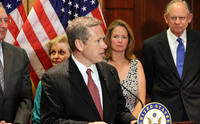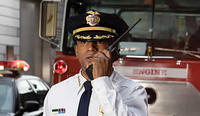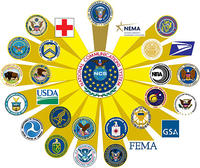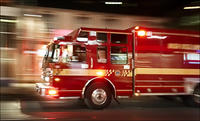-
WILDFIRESImproving Strategy for Social Media Communications During Wildfires
In the last 20 years, disasters have claimed more than a million lives and caused nearly $3 trillion in economic losses worldwide. Specifically examining wildfires, researchers contradict existing crisis communication theory that recommends Disaster relief organizations (DROs) speak with one voice during the entirety of wildfire response operations.
-
-
Emergency communicationRI’s new emergency manager makes disaster communication key priority
One of the top priorities for Theresa C. Murray, Rhode Island’s new executive director of emergency management, is communication particularly among government employees during a major attack or a disaster
-
-
Emergency communicationDHS IG: Cook County communications program botched

On Monday the DHS Inspector General blasted officials in Cook County, Illinois for mishandling a $45 million federally funded project to upgrade communications equipment for first responders; the Inspector General said the Cook County program, dubbed Project Shield, was fraught with trouble from the start, resulted in equipment that did not work, and potentially wasted millions of taxpayers’ dollars
-
-
Police communicationLAPD abandons plans to move to Google cloud server
The Los Angeles Police Department (LAPD) recently announced that it had scrapped its plans to move its email servers to a Google-based cloud system citing the technology’s inability to meet certain FBI security requirements
-
-
First response gearNY counties receive money to prepare for emergencies
The magnitude of Hurricane Irene and Tropical Storm Lee posed serious communications challenges to the response and recovery efforts among many New York counties; these counties are now receiving $20 million in funding to help localities better respond to emergency situations
-
-
Emergency communicationAtlanta debuts new emergency communications systems
Last week first responders in Atlanta, Georgia gained a valuable new tool in helping to reduce 911 response times and improve communication during a disaster
-
-
Emergency comm.Local towns signing up for Twitter and Facebook for emergency comm.
Following the lead of several other cities and federal agencies, the town of Wilton, Connecticut recently launched a Facebook page and Twitter account to help communicate with residents and share information during a disaster
-
-
Emergency communicationDHS completes Multi-Band Radio testing

Last week DHS completed testing on a sophisticated new multi-band radio that will allow first responders to communicate with multiple agencies and jurisdictions operating on different radio bands; beginning in May 2012, first responders will have the opportunity to purchase the Harris XG-100 Unity radio system; the Unity radios can replace up to five different radios, roughly the equivalent cost of just one high-end portable radio
-
-
CommunicationsIllinois distributes $3.4 million to help first responders upgrade radios

Earlier this week the Illinois Terrorism Task Force (ITTF) announced that it was awarding more than $3.4 million to 156 local emergency response agencies across the state to upgrade their communications equipment; the funds come from DHS grants designed to help states comply with new federal communications requirements aimed at relieving congestion and increasing channels on non-narrowband radios
-
-
Emergency communicationDC officials receive priority disaster phone access

During major disasters or a terrorist attack, phone lines quickly become inundated with traffic which makes it nearly impossible for residents to make calls or send texts; to ensure that local officials have the ability to communicate during disasters, DHS recently issued special calling cards to members of the Washington, D.C. City Council that allow their calls to take priority during moments of heavy phone traffic
-
-
Emergency communicationGraduate student develops emergency communication Twitter app
A graduate student at the University of Colorado has developed a smartphone app that makes it easier for first responders and emergency personnel to communicate via Twitter during disasters; without a standardized syntax, emergency personnel, affected individuals, information officers, and journalists were having trouble communicating on Twitter
-
-
Biometric Consortium Conference & Expo 2011Predicting race and ethnicity from irises now possible

Conventional wisdom holds that irises, like fingerprints, are unique to each individual and have little similarities between ethnic groups or gender, but a groundbreaking new study indicates that biometric scanners can actually predict race and gender based on iris texture alone; the study’s findings are important in that it opens new avenues for research that previously were not thought possible
-
-
Human-machine communicationProton-based transistor could let machines communicate with humans
Devices humans use, from light bulbs to iPods, send information using electrons; human bodies and all other living things, on the other hand, send signals and perform work using ions or protons; researchers build a novel transistor that uses protons, creating a key piece for devices that can communicate directly with living things
-
-
Chris Russo, founder of ELERTS CorporationEmergency communication remains a challenge ten years after 9/11
Chris Russo, a twenty-five year firefighting veteran, a 9/11 first responder, and the founder of ELERTS Corporation, discusses the challenges first responders face in communicating with each other in major disasters, the lack of progress made to create an inter-operable system for emergency responders, and how technology is changing how authorities communicate and interact with the public during major disasters
-
-
Emergency communicationLaw enforcement still unable to communicate ten years after 9/11

Ten years after the 9/11 attacks, emergency responders from varying agencies still lack the communications tools to effectively communicate with one another; during the chaos of the 9/11 attacks, emergency responders had difficulty communicating and the 9/11 Commission recommended that a nationwide broadband network be created for emergency responders, but ten years later, according to the Commission’s ten year report card, this nationwide network “continues to languish”
-
- All
- Regional
- Water
- Biometrics
- Borders/Immig
- Business
- Cybersecurity
- Detection
- Disasters
- Government
- Infrastructure
- International
- Public health
- Public Safety
- Communication interoperabillity
- Emergency services
- Emergency medical services
- Fire
- First response
- IEDs
- Law Enforcement
- Law Enforcement Technology
- Military technology
- Nonlethal weapons
- Nuclear weapons
- Personal protection equipment
- Police
- Notification /alert systems
- Situational awareness
- Weapons systems
- Sci-Tech
- Sector Reports
- Surveillance
- Transportation
Advertising & Marketing: advertise@newswirepubs.com
Editorial: editor@newswirepubs.com
General: info@newswirepubs.com
2010-2011 © News Wire Publications, LLC News Wire Publications, LLC
220 Old Country Road | Suite 200 | Mineola | New York | 11501
Permissions and Policies
Editorial: editor@newswirepubs.com
General: info@newswirepubs.com
2010-2011 © News Wire Publications, LLC News Wire Publications, LLC
220 Old Country Road | Suite 200 | Mineola | New York | 11501
Permissions and Policies
